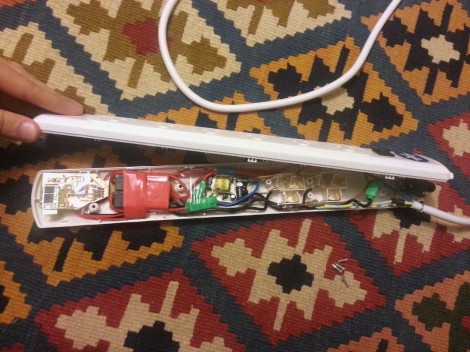
[Mansour] had a ceramic space heater mounted near the ceiling of his room. Since heat rises this is not the best design. He upgraded to an infrared heater which works a lot better, but lacks the timer function he used on the old unit. His solution wasn’t just to add a timer. He ended up building a Bluetooth module into a power strip in order to control the device wirelessly. He ends up losing all but two outlets on the strip, but everything fits inside the original case so we think it’s a reasonable trade-off.
He uses relays on both the live and neutral wires to switch the two outlets. These are driven via MOSFETs to protect the ATmega168 which controls the board. The microcontroller and Bluetooth module both need a regulated DC power source, so he included a transformer and regulator in the mix. After the break you can see him demonstrating the system using two lamps. There’s even a terminal interface which lets you select different control commands by sending the appropriate character. This interface makes script a breeze.
At least this power strip doesn’t spy on you.














One thing that I’ve wanted that no one seems to make is a power bar that plugs into a USB port, and when the computer turns off, it would turn off all the wall-warts and speaker power that aren’t needed. (I could that manually .. with my foot .. if I remembered…)
I have that on my battery backup, it will sense when the pc is off and turn the “sensed” outlets off
There are a number of power bars that offer this sort of function. Either using USB, or that will switch the other outlets on or off depending on the draw from one unswitched outlet. (i.e. you plug the computer or TV into the unswitched outlet. When it is on the power bar senses that it is using more power and turns on the other outlets. When the main item turns off the power bar turns off the other outlets).
Availability may depend on what country you are in. There are many of these for North American voltage and plug type. Have seen at least one or two for UK. Not sure about other areas.
For instance, search for USB controlled outlet
That’s easy enough to hack. All you need is a relay that has a 5V coil, and contacts rated for the mains voltage and current you’ll encounter. Drive the relay coil with the USB power.
There was a HAD project a couple years back that did just that. If it wasn’t HAD it was lifehacker, but I’m pretty sure if it was lifehacker, they would have been reposting the project from here anyway.
Just so you know heat doesn’t rise, hot air rises. Heat goes to cold.
Much like how heat doesn’t rise, it doesn’t just “go to cold”, it has to be absorbed by something else. It’s still there.
Cold doesn’t technically exist either, cold is a concept of the non-existence of heat ;)
This was quite a bit more work than necessary..
Those bluetooth modules have a number of GPIO’s that can be accessed from AT mode, but other firmwares allow you to get to AT mode over the bluetooth connection and actuate the GPIO remotely. Very useful, but you might need a transistor in between as the csr chip probably can’t sink the relay hold current.
I like it. But isn’t it generally better not to switch the neutral as well as the hot? (Similar to how you shouldn’t put a fuse on the neutral side.)
You don’t put a fuse on neutral because if the neutral fuze blows it leaves the device “hot”.
You can switch both hot and neutral with no problems. No one really does it though. Requires a double pole switch instead of just a single pole.
It is a no-no to switch just the neutral.
I have witnessed too many screw ups in house electrical wiring not to trust which lead is the live and which is the neutral one. Curiously enough, the mechanical switch on all the wall sockets and all the power boards switch both leads.
I hope the strip is well overrated for the current the heater draws. In general it’s not a good idea to hook up a space heater to a strip or an extension cord. Many houses have been burnt down that way.
The relays are rated at 10Amp 250v continuous use and all the wiring for up to 18Amp. The heater pulls about 6-7Amps. The board does get a little warm, both from the heat of the DC adapter and the relays themselves (all four use 1.4Watts). I have closely monitored the temperature for 24 hours before I let it work unsupervised. I would have liked to use higher rated relays, but that’s all I had lying around.
Solid state mains rated relays exist, based on zero crossing power triacs.
A similar method exists which uses a special chip to convert 240V (hot) to 12V which is enough to power a micro but is still connected to mains potential.
So ideal for something radio linked but not safe for direct PC connection.
Alternate idea, use a Bluetooth headset with a tone detector on its output and a feedback circuit to confirm switching if needed.
I’m not sure how safe would a triac be when used in a generic power board. There will be no circuit isolation and while it is supposedly off, you could still get electrocuted.